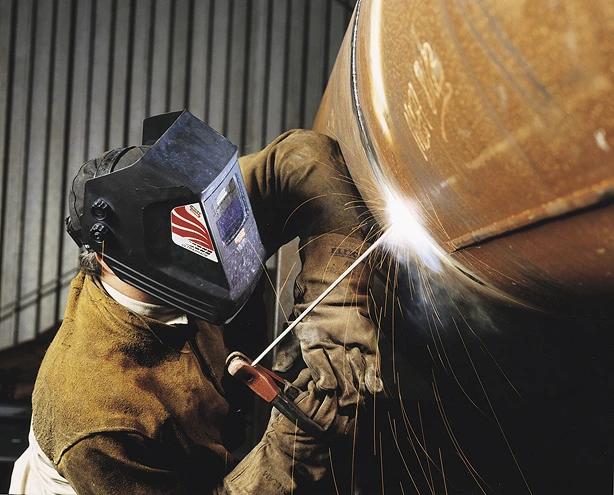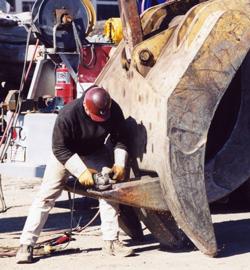Everything about Welding: Trick Insights Into Techniques and Best Practices for Success
Welding incorporates a range of strategies, each fit for certain products and applications. Understanding these approaches, such as GMAW, SMAW, and TIG, is necessary for achieving excellent results. Moreover, the best equipment and safety and security techniques can not be forgotten. As prep work and troubleshooting play crucial roles in the welding process, understanding these elements can substantially enhance the quality of the final item. What are the essential variables that guarantee an effective weld?
Recognizing Different Welding Methods
Welding techniques include a variety of methods, each matched to particular applications and materials. Among the most usual strategies are Gas Steel Arc Welding (GMAW), Shielded Steel Arc Welding (SMAW), and Tungsten Inert Gas Welding (TIG) GMAW, also referred to as MIG welding, is preferred for its speed and flexibility, making it perfect for slim products. SMAW, or stick welding, is favored for its simplicity and performance in outside environments, particularly with thicker metals. TIG welding offers precision and control, making it appropriate for complex work and non-ferrous metals (Montana Mobile Welding and Repair Belgrade Welding). Each method has its one-of-a-kind benefits and considerations, permitting welders to pick the very best technique based on the project's needs, product type, and preferred results. Recognizing these methods is essential for successful welding
Necessary Welding Devices and Devices
While various welding strategies need specific abilities, the ideal equipment and devices are equally necessary for achieving top quality results. Important welding equipment includes welding equipments, which vary depending on the method-- such as MIG, TIG, or stick welding. Safety equipment, including aprons, helmets, and gloves, warranties safety and security and comfort throughout the procedure. On top of that, components and clamps assist secure materials in place, making certain accuracy in welds. Consumables like welding rods, cord, and shielding gas are also essential elements that affect the quality of the weld. Tools such as mills and cutters assist in surface preparation and post-weld finishing, contributing to an expert end result. Buying top quality devices inevitably enhances the efficiency and effectiveness of welding tasks.
Security Practices in Welding
Appropriate security techniques are important in the welding market to shield employees from possible hazards. Welders should use suitable personal safety tools (PPE), consisting of headgears with appropriate shading, gloves, and flame-resistant garments. Appropriate air flow is important to decrease direct exposure to dangerous fumes and gases generated during the welding procedure. Additionally, employees should be learnt the appropriate handling of welding equipment to avoid mishaps. Fire safety and security actions, such as maintaining combustible products away from the welding location and having fire extinguishers readily available, are required. Normal evaluations of equipment and work spaces can assist identify prospective risks before they lead to crashes. By adhering to these safety practices, welders can create a much safer working environment and minimize threats related to their trade.
Readying Materials for Welding
Preparing materials for welding is an essential step that considerably affects the top quality and stability of the end product (Fabrication). Correct preparation entails cleaning up the surfaces to remove impurities such as dust, oil, and corrosion, which can jeopardize the weld. Strategies such as grinding, sanding, or making use of solvents are typically utilized to achieve a clean surface. Furthermore, guaranteeing that the materials mesh snugly is important; spaces can cause weak welds. It's additionally essential to consider the positioning and positioning of the components, as this will impact the ease of welding and the last result. Choosing the proper filler product and guaranteeing compatibility with the base steels is necessary for attaining strong, durable welds.
Tips for Achieving High-Quality Welds
Achieving top notch welds needs focus to detail and adherence to finest techniques throughout the welding procedure. Appropriate joint preparation is necessary, ensuring surface areas are clean and complimentary from pollutants. Picking the proper filler product and welding technique based upon the base steels is vital for ideal bonding. Preserving regular traveling speed and angle while welding can promote and prevent problems uniformity. Additionally, regulating heat input is vital; too much warm can lead to bending and compromised joints. If essential, on a regular basis examining the welds more info throughout the process enables for prompt adjustments. Lastly, using ideal post-weld therapies, such as cleansing and anxiety alleviation, can enhance the sturdiness and integrity of the weld, eventually guaranteeing a successful outcome.
Repairing Typical Welding Issues
Welding typically provides obstacles that can impact the high quality and honesty of the last item. Common issues such as porosity, irregular weld grains, and overheating can occur, each requiring details troubleshooting methods. Recognizing these troubles is vital for welders to improve their abilities and attain excellent outcomes.
Porosity Issues Explained
Porosity can usually be ignored, it continues to be a critical problem in welding that can compromise the integrity of a completed product. Porosity refers to the existence of tiny gas pockets within the weld grain, which can lead and deteriorate the joint to premature failing. This issue commonly arises from pollutants, dampness, or incorrect securing gas protection during the welding process. To minimize porosity, welders ought to confirm that the base products are completely dry and tidy, use proper protecting gases, and maintain regular welding parameters. Regularly evaluating the tools and atmosphere can likewise help identify prospective problems before they manifest in the weld. Resolving porosity effectively is crucial for achieving strong, durable welds that satisfy high quality requirements.

Irregular Weld Beads
Inconsistent weld grains can substantially affect the top quality and strength of a finished item. Different elements contribute to this problem, including improper travel speed, inaccurate amperage setups, and inconsistent electrode angles. When the welder relocates also quickly, a bead may appear narrow and lack penetration, while moving too gradually can trigger too much buildup. In addition, using the wrong amperage can lead to either damaging or too much spatter, both of which compromise weld stability. The welder's strategy, such as irregular torch activity, can also result in unequal grain appearance. To mitigate these troubles, welders should focus on keeping constant, controlled activities and ensuring appropriate equipment setups to attain uniformity in their welds. Consistency is vital to achieving trusted and solid welds.
Overheating and Warping Issues
Too much warm throughout the welding procedure can cause significant getting too hot and contorting issues, impacting the architectural integrity of the workpiece. These problems commonly materialize as distortion, which can jeopardize placement and fit-up, making more setting up challenging. Elements adding to overheating consist of the option of welding criteria, such as voltage and take a trip speed, along with the kind of product being welded. To alleviate these problems, welders should keep consistent traveling speed and ideal warmth input while monitoring the work surface temperature. In addition, preheating or post-weld warmth therapy can aid alleviate tensions brought on by fast cooling - Welding. Routine assessment and adherence to best techniques are important in preventing getting too hot and making sure the durability and reliability of bonded structures
Frequently Asked Inquiries
What Are the Profession Opportunities in the Welding Industry?
The welding sector supplies diverse profession chances, consisting of settings as welders, designers, examiners, and educators. Experts can operate in production, construction, aerospace, and auto fields, taking advantage of strong demand and affordable incomes in different functions.
How Can I Boost My Welding Speed Without Sacrificing Top Quality?
To boost welding rate without giving up top quality, one ought to exercise effective strategies, keep tools, maximize settings, and improve hand-eye control. Routine training and looking for responses can additionally substantially add to accomplishing quicker, top notch welds.
What Accreditations Are Available for Welders?
Countless accreditations exist for welders, including those from the American Welding Society (AWS), the National Facility for Building Education And Learning and Research Study (NCCER), and numerous industry-specific companies. These qualifications improve employability and show skill effectiveness.
Exactly How Does Welding Influence the Properties of Metals?
Welding influences the buildings of metals by modifying their microstructure, which can lead to changes in toughness, firmness, and ductility. Warmth input and cooling prices throughout the process greatly influence these product attributes.
Can I Weld Dissimilar Metals Together?
